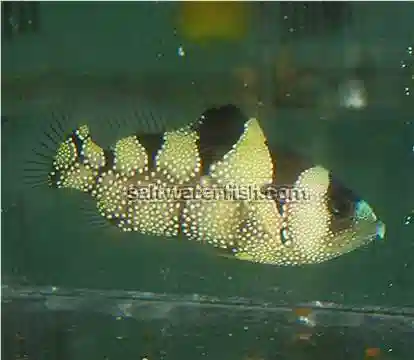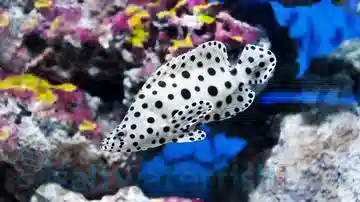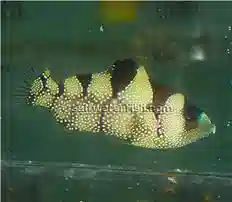Clown Grouper
Pogonoperca punctata
(1 Reviews)

Clown Grouper
Pogonoperca punctata
(1 Reviews)
{{ item.name }}
Size: {{ item.extra_field_3 }}
${{ getFormattedPrice(item.saleprice) }} ${{ getFormattedPrice(item.price) }}
To join the waiting list, click here
Free Shipping
With
$199.00
or more in Marine Life.
More details...
Clown Grouper Care Facts
| Care Level: | Easy |
|---|---|
| Temperament: | Aggressive |
| Diet: | Carnivore |
| Reef Safe: | No |
| Minimum Tank Size: | 120 gallons |
| Max Size: | 14 inches |
The Clown Grouper: Adding Unique Charm to Your Saltwater Aquarium
The Clown Grouper, scientifically known as Pogonoperca punctata, is a captivating marine species that adds a unique charm to saltwater aquariums. This educational product description provides essential insights into maintaining this species in captivity, covering aspects such as habitat, reef compatibility, size, lifespan, diet, aquaculture availability, compatibility with other marine life, sexual dimorphism, coloration changes, temperament, tank requirements, and water conditions.
Habitat: Creating a Natural Environment for Clown Groupers
Originating from the Indo-Pacific region, Clown Groupers are commonly found in coral-rich environments, especially lagoons and outer reef slopes. Their preference for rocky outcrops and caves makes them a fascinating addition to aquariums with ample hiding spaces.
Reef Compatibility: Considerations for Reef Tanks
Caution should be exercised when considering the Clown Grouper for a reef aquarium. While juveniles are generally reef-safe, adult specimens may develop a taste for smaller fish and invertebrates. Therefore, careful monitoring and strategic tank planning are crucial to maintaining a harmonious environment for all inhabitants.
Size and Lifespan: Growth and Longevity of Clown Groupers
Clown Groupers have a moderate growth rate, reaching up to 14 inches in length. They can live for a considerable period with proper care, often surpassing a decade. This longevity makes them a rewarding choice for committed marine enthusiasts.
Diet in Captivity: Ensuring a Nutrient-Rich Diet
Clown Groupers are carnivorous predators, thriving on a diet of high-quality marine-based pellets, frozen foods, and live prey. A varied diet ensures optimal health and coloration, replicating their natural feeding habits.
Aquaculture and Availability: Responsible Sourcing from Saltwaterfish.com
As of now, Clown Groupers are not extensively aquacultured, making them a sought-after addition for aquarium enthusiasts. However, their availability may vary, and enthusiasts are encouraged to source them responsibly from reputable suppliers like Saltwaterfish.com.
Compatibility with Other Fish and Invertebrates: Choosing Tank Mates Wisely
While generally peaceful, Clown Groupers can display territorial behavior, especially towards other fish of similar size. Careful selection of tank mates is crucial to prevent aggression. Compatible tank mates include Ocellaris Clownfish, Firefish, Royal Gramma, and Banggai Cardinalfish species.
Sexual Dimorphism: Challenges in Distinguishing Male and Female
Distinguishing between male and female Clown Groupers can be challenging without specific breeding behavior. In captivity, they are primarily appreciated for their unique appearance and compatibility rather than for breeding purposes.
Juvenile to Adult Coloration Changes: Aesthetic Transformations
Juvenile Clown Groupers showcase striking patterns and vibrant colors, often characterized by bold markings and contrasting shades. As they mature, these patterns may become more subdued, giving way to a more uniform coloration, typically with a stunning combination of reds, browns, and whites.
Temperament: Balancing Calm Disposition with Territorial Behavior
Known for their calm disposition, Clown Groupers are generally well-suited for community aquariums. However, occasional territorial behavior may be observed, necessitating careful observation and adequate hiding spots for all tank inhabitants.
Tank Requirements: Creating a Well-Thought-Out Tank Setup
Maintaining a Clown Grouper in captivity requires a well-thought-out tank setup. A minimum aquarium size of 120 gallons is recommended to provide ample swimming space and accommodate their potential territorial behavior. Incorporating live rock structures and caves replicates their natural habitat, fostering a secure environment.
Water Conditions: Maintaining Optimal Parameters
Maintaining optimal water conditions is paramount for the health of Clown Groupers. Recommended parameters include a pH range of 8.1-8.4, salinity between 1.020-1.025, water temperature of 74-78°F, and moderate water flow. Regular monitoring and adjustments are essential to ensure a stable and conducive environment.
Other Common Names: Alternative Titles for the Clown Grouper
Clown Groupers are known by various names, including Spotted Coral Grouper, Dot-and-Dash Grouper, and Red Sea Clown Grouper.
Five Compatible Tank Mates: Choosing Companions Wisely
- Ocellaris Clownfish (Amphiprion ocellaris)
- Firefish (Nemateleotris magnifica)
- Royal Gramma (Gramma loreto)
- Banggai Cardinalfish (Pterapogon kauderni)
- Coral Beauty Angelfish (Centropyge bispinosa)
Why Choose Clown Grouper from Saltwaterfish.com: Ensuring Quality and Reliability
Saltwaterfish.com stands out as a reputable supplier, offering healthy and ethically sourced marine life, including the Clown Grouper. Their commitment to sustainable practices, quality assurance, and diverse marine species make them a preferred choice for enthusiasts looking to enhance their saltwater aquariums.
In conclusion, the Clown Grouper presents a captivating addition to saltwater aquariums, showcasing a blend of beauty and unique behaviors. By adhering to proper care guidelines, enthusiasts can enjoy the presence of this remarkable species while contributing to the preservation of marine life in captivity.
This is a great Clown Grouper - South Asia who showed up healthy and happy. He was shy at first in my quarantine tank but after moving him over to the main tank he has been quite the showman. Beautiful fish to add to a reef tank.
Reviewed by: James Thompson on Sept. 12, 2021















